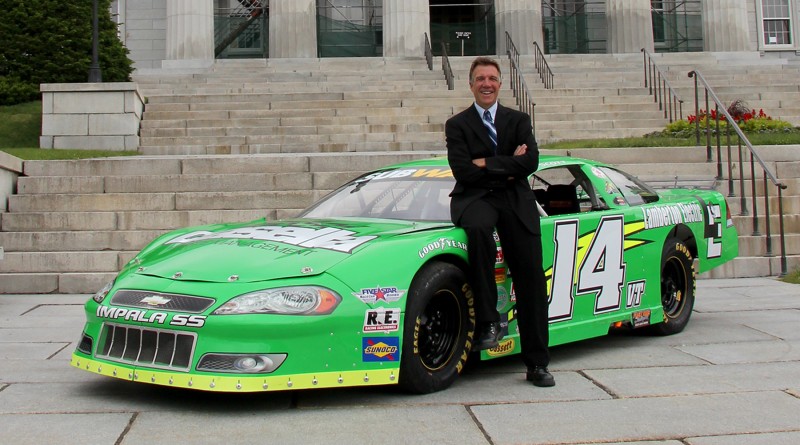Phil Scott: Life at Full Throttle
Throughout Phil Scott’s political life, one thing has always been taken for granted: he’s just as happy racing his #14 race car at Barre’s Thunder Road, as playing politics in Montpelier. But after 10 years as a state senator representing Washington County, and the past six years as Lt. Governor, Scott’s competitive nature has him racing for the state’s top political office.
“He’s definitely driven to compete, it’s part of his DNA,” says long-time friend Jeff Newton, who is now general manager and soon to be partner at the DuBois Construction company in Middlesex at which Scott has been a partner for the past 30 years.
That competitiveness started when Scott was a young boy racing homemade wooden cars in the close-knit neighborhoods of Barre back in the late 1960s. “Growing up in Barre was my first introduction to Thunder Road,” Scott recalled in a recent interview. “Through our early teens, about a dozen of us boys would be out racing our cars every night of the summer. We’d paint our cars after our favorite drivers at Thunder Road. Our parents and neighbors would come watch the street corners, making sure there were no cars coming as we raced down the hills and through the intersections.”
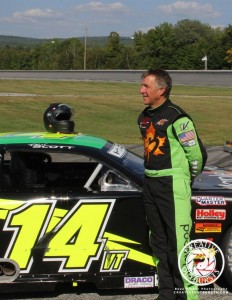 Those early races were a natural transition to working on a race team as a 16- and 17-year-old with well-known racer at the time, Robbie Crouch. “My mother loved to go to the races at Thunder Road, that’s how I got started working in the race pits for mechanics. I always loved to build things, create things. It was natural for me, and I had an instant attraction to race cars and competing right off the bat.” But the bug had been planted even earlier than a young Phil Scott knew at the time. Thunder Road was built about the time Scott was born in 1958.
Those early races were a natural transition to working on a race team as a 16- and 17-year-old with well-known racer at the time, Robbie Crouch. “My mother loved to go to the races at Thunder Road, that’s how I got started working in the race pits for mechanics. I always loved to build things, create things. It was natural for me, and I had an instant attraction to race cars and competing right off the bat.” But the bug had been planted even earlier than a young Phil Scott knew at the time. Thunder Road was built about the time Scott was born in 1958.
Because the partners of Thunder Road, one of whom was Ken Squire, didn’t have all the financial resources they needed, they struck a deal with Scott’s uncle, Ruie DuBois, owner of Dubois Construction, who helped build the race track and was repaid by a percentage of the gate receipts each Thursday night. Back then, Barre’s granite workers were paid on Thursday’s, which is why the races were held that night. “They wanted to get the first bite out of the apple so to speak,” said Scott, and it’s been tradition ever since. “Literally, racing is part of the social fabric of central Vermont,” Scott added. “It’s amazing, we come from such a green state, but racing is so important to so many people in Barre and throughout the state.”
But car racing was expensive and wasn’t in Scott’s immediate future. Scott’s father, Scotty, was a World War II veteran who lost both legs in the D-Day invasion and later died from complications when Phil was just 11. One uncle would later buy Phil his first shotgun and teach him how to hunt, while another taught him how to ride snowmobiles, a harbinger of Scott’s passion for motorsports.
By the time he graduated from Spaulding High School and entered the University of Vermont to get a degree as a shop teacher, he had also started pursuing wilder days as a top snowmobile racer. After graduating from UVM in 1980, he opened a motorcycle shop in Morrisville, partly to feed his passion for racing snowmobiles throughout New England and into Canada, frequently going up in Ontario, over to Eagle River, Wisc., and into Manitoba. “I loved to compete, and make things go faster,” Scott said simply of his unrelenting passion for speed. “I was decent,” he says of his racing success, “but I was racing on a world-class level at that point. I wasn’t top of the field by any means. I was good in New England and won a couple of New England championships and became relatively well-known in the 1980s, but when we stretched it out to the world-class level, the competition was tough … We competed with guys that raced Formula One… on twin tracks that were iced down. It was incredibly fast, 110 mph or more, and there was a lot of crashing.”
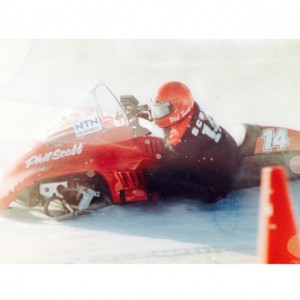 With a laugh that belied the near-miss danger of one crash, he recalls the story: “In Skowhegan, Me., I got crossed up over someone’s skis at a fairground, shot up over the bales of frozen hay on a corner and a photographer caught me flying about 25 feet in the air over a fun house. They took me (a buddy came along) to the hospital in an ambulance, checked me over and discovered I just had scrapes and bruises but nothing broken, so we left the hospital and hitched a ride back to the races. A guy in a pick-up gave us a lift, and asked where we were going. We told him to the snowmobile races. ‘I was there this morning,’ he starts telling us, ‘and I think somebody must have died. The guy flew into the air over a building and landed on the ice. Nobody thinks he made it.’ That was me, of course, and we got back to races and, four to five hours after the crash, I was entered into the late afternoon race with my other snowmobile.”
With a laugh that belied the near-miss danger of one crash, he recalls the story: “In Skowhegan, Me., I got crossed up over someone’s skis at a fairground, shot up over the bales of frozen hay on a corner and a photographer caught me flying about 25 feet in the air over a fun house. They took me (a buddy came along) to the hospital in an ambulance, checked me over and discovered I just had scrapes and bruises but nothing broken, so we left the hospital and hitched a ride back to the races. A guy in a pick-up gave us a lift, and asked where we were going. We told him to the snowmobile races. ‘I was there this morning,’ he starts telling us, ‘and I think somebody must have died. The guy flew into the air over a building and landed on the ice. Nobody thinks he made it.’ That was me, of course, and we got back to races and, four to five hours after the crash, I was entered into the late afternoon race with my other snowmobile.”
In those days, Scott raced most every weekend in the winter, traveled a lot, and held other jobs delivering fuel oil, working side jobs as a plumber, carpenter and welder to pay the bills. He broke a few ribs, and a shoulder once, making his fuel oil delivery job at the time a trying experience, he says, adding in the voice of a wiser man, “stupid, stupid stuff.” What was driving him back then? “It’s that inner competition, trying to outdo everyone else… it was the need for speed. It certainly satisfied me in many ways, always trying to do better, build a better mousetrap, make it go faster.”
That was in the late 1980s. After an attempt to expa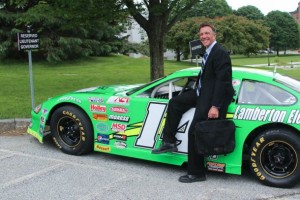 nd his motorcycle shop was stopped by an Act 250 cease and desist order which forced a year delay, he decided to scrap the expansion and join his uncle’s construction firm in Middlesex. He maintains that at the time he didn’t even know what an Act 250 permit was, or why you needed one, but the experience may have sparked his interest in politics. A decade later, in 2000, he ran for a Senate seat in Washington County as a businessman first and politician second, and won. Since then, Scott’s other life has been in Montpelier.
nd his motorcycle shop was stopped by an Act 250 cease and desist order which forced a year delay, he decided to scrap the expansion and join his uncle’s construction firm in Middlesex. He maintains that at the time he didn’t even know what an Act 250 permit was, or why you needed one, but the experience may have sparked his interest in politics. A decade later, in 2000, he ran for a Senate seat in Washington County as a businessman first and politician second, and won. Since then, Scott’s other life has been in Montpelier.
While never considering himself a politician, he nonetheless started working where his experience led him: on the Land Use Permitting Process Interim Committee, where, a year and a half later, changes to the Act 250 process would help speed up the process and make it less onerous. Over the past 16 years, Scott has proved himself, politically, to be a social moderate and fiscal conservative. He now supports gay marriage, is pro-choice and is not a denier of climate science, though is an advocate for “sensible” energy policies that include natural gas expansion while being opposed to ridgetop development of wind-powered turbines.
As the Republican candidate for governor, Scott’s primary focus has been on what he calls “Vermont’s affordability crisis,” a catch-all phrase that lumps in problems associated with the high cost of living in Vermont relative to income. He has a 50-point economic development plan that is the crux of his campaign, featuring a mix of tax incentives to spur job growth and a frugal approach to spending. Not a political activist, as some Republicans want him to be, Scott prefers compromise to ideology. Remarried to wife, Dianna, a nurse who is also a runner and cyclist, he has two grown daughters from a previous marriage: Erica, 30, and Rachael, 28.
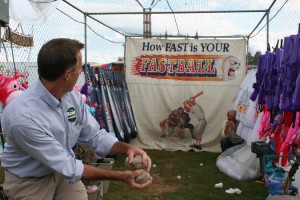 Asked how the state’s outdoor recreation industry fits into his economic plan, Scott says recreation and job growth go “hand in hand. I think we’ve got a great brand in terms of some of the products we have, and we are also developing a strong brand in outdoor recreation,” but he cautioned that the state needed to pay more attention to biking routes and improve and widen the shoulders. “If we want people to have a good experience, we have to provide them with the infrastructure and good maintenance.”
Asked how the state’s outdoor recreation industry fits into his economic plan, Scott says recreation and job growth go “hand in hand. I think we’ve got a great brand in terms of some of the products we have, and we are also developing a strong brand in outdoor recreation,” but he cautioned that the state needed to pay more attention to biking routes and improve and widen the shoulders. “If we want people to have a good experience, we have to provide them with the infrastructure and good maintenance.”
Scott noted that Vermont has already has done a good job developing a rapidly growing mountain biking scene, as well as many other adventure sports, but could use help in marketing those activities by a more aggressive marketing campaign. “In all these different sports and activities, we need to have a common message.” Scott said he would enhance what the tourism department is doing now, noting that he “thought it was incredibly short-sighted two years ago when there was talk in the House about doing away with the tourism budget. I mean tourism is the one thing that we have as a state that is doing well, and we’d do away with it? That’s the most ridiculous thing I’ve ever heard. We should nurture it, enhance it.”
The 1990s saw Scott become more involved in the earth-moving construction business with his partner Ron DuBois, who is president of the company, and a decade later get into politics. At the same time, Scott was making a name for himself as a race car driver. He started at Thunder Road in the early 1990s, but says it didn’t come easy. “I wasn’t an instant success, believe me,” he recalled. “I had a steep learning curve, and I was in my early 30s, late in life for racing.”
But by 1996, at the age of 38, he won his first late model series race at Thunder Road, the highest level of short-track racing in this part of the county. Thunder Road is a paved ¼ mile track with racers hitting speeds of 75-80 mph, completing a lap in about 13-seconds. And with 25-plus cars on the track, “things are coming at you pretty fast,” Scott says, emphasizing the need for quick reactions and a high level of physical fitness. In mid-summer, Scott explained, cockpit temperatures “can hit up to 150 degrees, and it’s easy to become dehydrated after losing several pints of water. Also during a race (and I’ve measured it using a heart monitor) my heart rate is similar to that seen when I’ve cycled a long-distance, (say 75-100 miles), reaching 75-85 percent capacity. And the lateral G-forces of going around on the banked track causes strain and fatigue, especially on my neck. Imagine driving around on the street with a 25-pound weight strapped to your head. The G-force also affects your legs and back for that matter, as you are simultaneously trying to use the throttle and brake while staying in your seat and keeping your legs from being thrown to the right. All the while, every muscle is tensed up due to adrenaline and competitiveness. When I’m in the seat racing every week, it feels like I work out every muscle.”
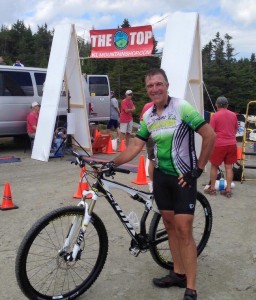
To keep in shape for snowmobiling and car racing, Scott started lifting weights in his late 20s and bike riding for stamina. Shocked by how difficult his first bike ride of 7 or 8 miles was (he says his legs cramped up and then seized), he dedicated himself to training and now routinely rides 20 to 25 miles a day, along with several century rides throughout the year, logging over 4,500 miles in 2015. An early riser, Scott says he routinely gets up at 4:30 a.m., goes to his exercise room, turns on the television news and pedals a stationary bike for half an hour or more, and then tries to get in a ride outside later in the day. “I’ve felt that by staying in shape, I might have had a little bit of an edge over some of my competitors, which has led to the success I’ve enjoyed.”
That success has included winning the prestigious Thunder Road Milk Bowl three times, and holding the track record for the most career wins at Thunder Road with 29. “But they’re catching me,” he jokes, even as, at age 58, he still raced most Thursday nights this past summer. Will he still race on Thursday nights if he wins the race for governor? “I’m not going to rule it out,” he says. “I’d love to do one or two races just to do something different, but I’m not even sure whom to ask. They’re very rigid in what you do as governor, but honestly, I’ve had more crashes on my bike than I have racing on the track.”
How has his success as a snowmobile racer, a racecar driver and his hours in the saddle of his bicycles (he also mountain bikes, kayaks, snowshoes and Nordic skis, among other sports,) shaped his view of Vermont and his vision for the state as governor? To his very core, he says. “When I think about Vermont and those parts of our DNA that make this state special, almost everything we’re known for revolves around our outdoors, our beauty and our spirit… that’s why we need to protect it, but also utilize it to our fullest advantage.” “Outdoor recreation drives a majority of the tourism in Vermont,” he adds, “and is a big part of how we market the state…It’s one of the reasons I am so focused on growing the economy because I know people will want to move to Vermont for the high quality of life, if we can just offer greater economic opportunities and a more affordable cost of living.”
To Newton, Scott’s goals as governor fit the portrait of his friend to a tee. “Whether it’s on the racetrack, snowmobiling, riding his bike, his business and now with politics, Phil always pushes himself to be better and better… and he has the right mindset: He’s very focused… he builds the right team with the right support staff. He’s an original, the real deal.”
All photos courtesy Phil Scott.

